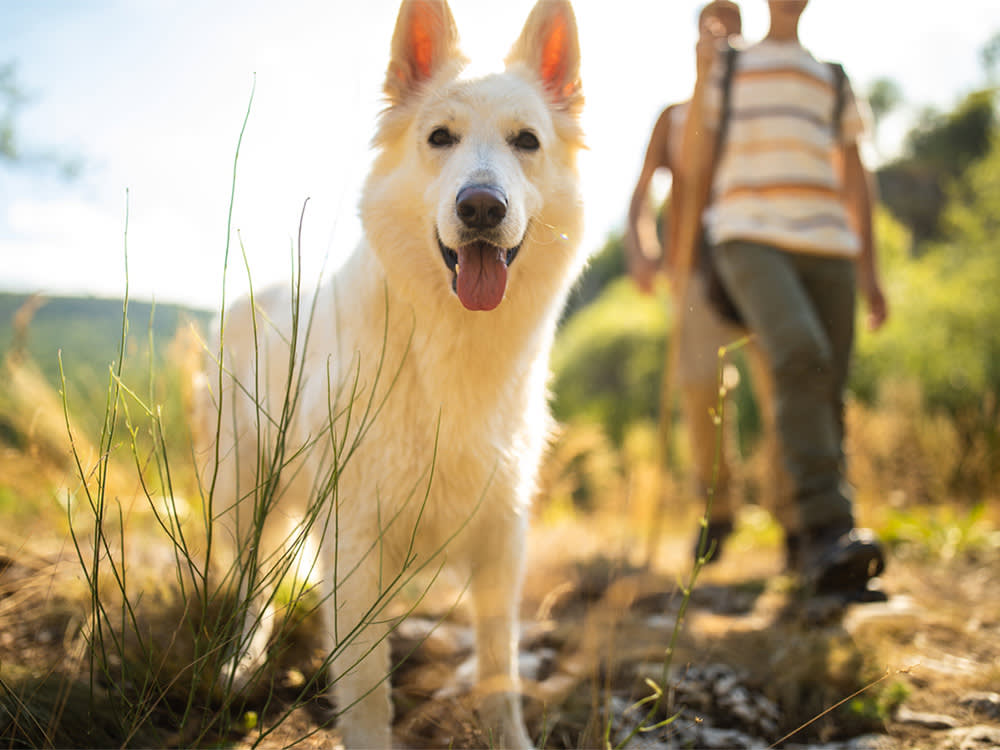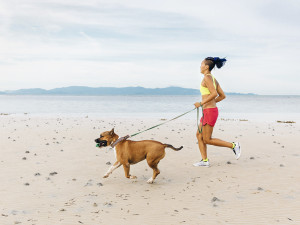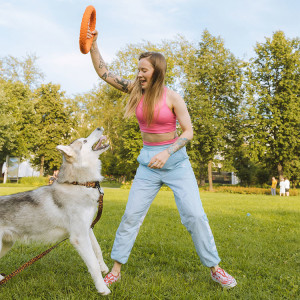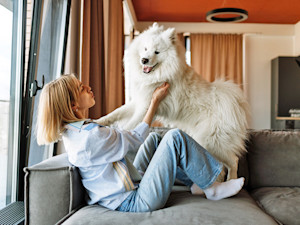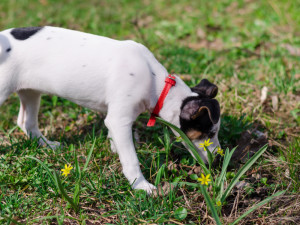How to Geocache with Your Dog
Come out, come out, wherever you are!
Sandi Pearce hid a small box in a park near her home in Dublin, Calif. Since then, hundreds of people, many with dogs, have searched for — and found — the box. It was just one of the 15 similar boxes that Pearce has hidden since she and her Border Collieopens in new tab, Katie, took up geocaching, an adventure game.
What is geocaching?
Geocaching is a high-tech treasure hunt in which players follow GPS coordinates listed on the geocaching app, and search for a cache, a term used to denote something hidden away for later. In geocaching, the “something hidden away” usually consists of a weather-resistant container holding a logbook and a mishmash of plastic toys, coins, key chains, and other small items for trade.
Trick question: All dogs are perfect! But find out which type is the best fit for you.
Thanks to GPS signals, a person’s position on the planet can be triangulated (within a range of 6 to twenty feet) and reported in latitude and longitude coordinates, giving them an idea of where to look for the cache. “It immediately appealed to me,” said Pearce. “It involves being outside, geeky tech toys, and a cool app. And I can take my dog with me.”
Taking their dogs along while caching is a practice enjoyed by many of the game’s participants. Sharon Lum, who caches with her mixed-breed rescue dog, Zoe, says she enjoys having a hobby she can participate in with her dog. “Before I discovered caching, I biked more,” she said. “Now some of that time is spent hiking for caches with Zoe, and I think she likes that.”
How much do you spend on your pet per year?
Is geocaching still a thing?
While global positioning satellite (GPS) navigation technology was initially developed by the military, in 2000, the government made the signals available to everyone, and geocaching popped into the outdoor-activity scene. It’s still a popular activity today, with over 120,000 active caches in more than 210 countries. Get started geocaching by joining the Geocachingopens in new tab app.
How does geocaching work?
You can find the best places to go geocaching with the app. Caches are hidden both in urban and rural areas. Several require moderate hikes and a few even require climbing, swimming, or boating. Each cache is rated for difficulty, based on how hard the cache is to find and on the terrain in which it’s secreted. There is no official dog-friendly rating in the cache descriptions, but many cachers will put notes about dog-appropriateness in the online log.
Lum, who has logged more than 1,000 finds, credits Zoe with fetching one cache of her own, near Lake Tahoe. “There was snow around, but only about a foot or so deep in some areas, and none in others. We searched for about half an hour at the coordinates, [then] decided to go back to the cachemobile, which was about a quarter of a mile away. As we were walking back, Zoe walked right up to the cache, which was nested next to a rock, pointed to it with her nose and then looked at me to say, ‘Okay, Mom, here it is. Can we go home now?’”
Tips for Geocaching with your dog:
Know your dog.
A dog who pulls on-leash or is easily distracted in urban areas likely won’t cache well in urban parks. For rural hiking, know your dog’s physical fitness level. Know if your dog is willing to cross a stream; if not, can you carry them over it? How will your dog behave if they encounter people or other animals (or cow patties)? It is better to ask these types of questions first and then plan accordingly.
Know the local laws.
Is a leash required? The law likely requires poop-scooping in urban areas, and even if it doesn’t, scooping is the polite thing to do. Bring those supplies with you!
Be prepared before you go.
Make sure your dog is current on all vaccinations, and use tick and mosquito protection for both of you. Consider a Lyme disease vaccination in areas where Lyme is prevalent. Check for ticks after caching in rural areas, and carry a tick puller. And bring water for both yourself and your dog.
Share dog-friendly caches.
If you hide a cache, consider mentioning in the log if it is dog-friendly, and list local leash laws. Have fun, and remember to take good pictures of your caching dog.
Geocaching 101
CITO: Cache In. Trash Out. When caching, never leave water bottles, food wrappers or other junk behind. Even if you didn’t bring trash in, take along a bag and carry some out. This practice keeps the sport pleasant for fellow cachers and for the planet in general. (When caching with your dog, remember the corollary motto: CIPO—Cache In. Poop Out.)
Geomuggle: Unabashedly borrowed from the Harry Potter books (where the term “muggle” means a nonmagical person), a geomuggle is a non-cacher. When a cache is found (and sometimes destroyed or moved) by a non-player, the cache is said to have been muggled.
Log: The record associated with each cache, in which players record a find or comment on a cache. In addition to the small notebook commonly in placed in the cache container, a log is maintained at the geocaching website, and cachers can upload photos and leave messages for other players.
Spoiler: Cachers live for the hunt. Some believe the more challenging the hide, the better. If a log entry provides clues that give away the location of a cache, it is labeled as a spoiler.
TNLN/SL: Took Nothing. Left Nothing. Signed Log. This notation is used when you wish to log a find but don’t trade items.
Travel Bug (hitchhiker): An item that travels from cache to cache. Some travel bugs (TB) travel in a serendipitous fashion, while others have specific missions. (Some are even designed to travel to dog-friendly caches). Each TB is outfitted with a special tag with an ID number so its travels can be tracked.
